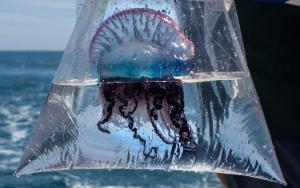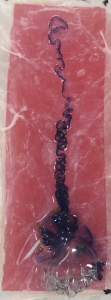UH scientists scrutinize first aid for man o' war stings
University of Hawaiʻi at MānoaPostdoctoral Fellow, JABSOM and SOEST
Angel Yanagihara, PhD, (808) 956-8328
Assistant Research Professor , JABSOM and SOEST
Video available here: https://youtu.be/ZirOV9wJ2jo
In recent decades, trusted first aid resources have recommended that stings from man o’ war (Physalia species) be treated differently from other jellies. But when researchers at the University of Hawai‘i at Mānoa dug into the scientific literature, they found scant evidence to support such individualized first aid. Adding to a recent push for evidence-based sting treatments, members of the Pacific Cnidaria Research Laboratory (PCRL) at UHM, Christie Wilcox, lead author of the paper and postdoctoral fellow, and Angel Yanagihara, senior author, head of the PCRL and assistant research professor at the UHM Pacific Biosciences Research Center and John A. Burns School of Medicine, teamed up with colleagues in Ireland to investigate which commonly recommended first aid actions (such as rinsing with seawater) are the most effective for Physalia stings. Their results, published this week in the journal Toxins, defy the recent abandonment of historic advice, and suggest that man o’ war stings are no different than other jellyfish stings: The best first aid is to rinse with vinegar to remove any residual stingers or bits of tentacle left on the skin and then immerse in 45°C (113°F) hot water or apply a hot pack for 45 minutes.
Physalia (Physalia utriculus, also called bluebottles in the Pacific or Physalia physalis, Portuguese man o’ war in the Atlantic) are among the most recognizable stinging jellies with their bright blue tentacles and colorful inflated floating sails. Strandings of bluebottles are common in Hawai‘i as the onshore winds push thousands of these small, painful critters onto the beaches. Similar mass strandings are frequent with the Atlantic species too, and have been known to cause hundreds of stings in a single day on beaches from Florida to France.
Yanagihara teamed up with Tom Doyle, a jellyfish scientist and lecturer with the National University of Ireland (NUI) Galway. Doyle and his team performed experiments using the Atlantic man o’ war in parallel with those conducted by Wilcox and Yanagihara in Hawai‘i. The results from opposite sides of the world lined up beautifully: the venom delivered by a man o’ war sting was lessened if the sting site was rinsed with vinegar, regardless of which species of Physalia was used. Even better, if you have it available, was Sting No More® Spray, a combined stinging capsule and venom-inhibiting product developed by Yanagihara with Department of Defense funding. Seawater rinsing, on the other hand, spread stinging capsules over more area and thus made stings, much worse. To treat stings after rinsing away the tentacles, both groups found 45 minutes of 45°C (113°F) heat application effectively inactived already-injected venom, while the application of ice packs made stings worse.
* * *
B roll clips available for download here:
https://www.dropbox.com/sh/g0g4lscdaci26ti/AADHtGVWQX11AhUp1OzJIKuJa/b%20roll%20clips?dl=0
For more information, visit: http://go.hawaii.edu/j4r


